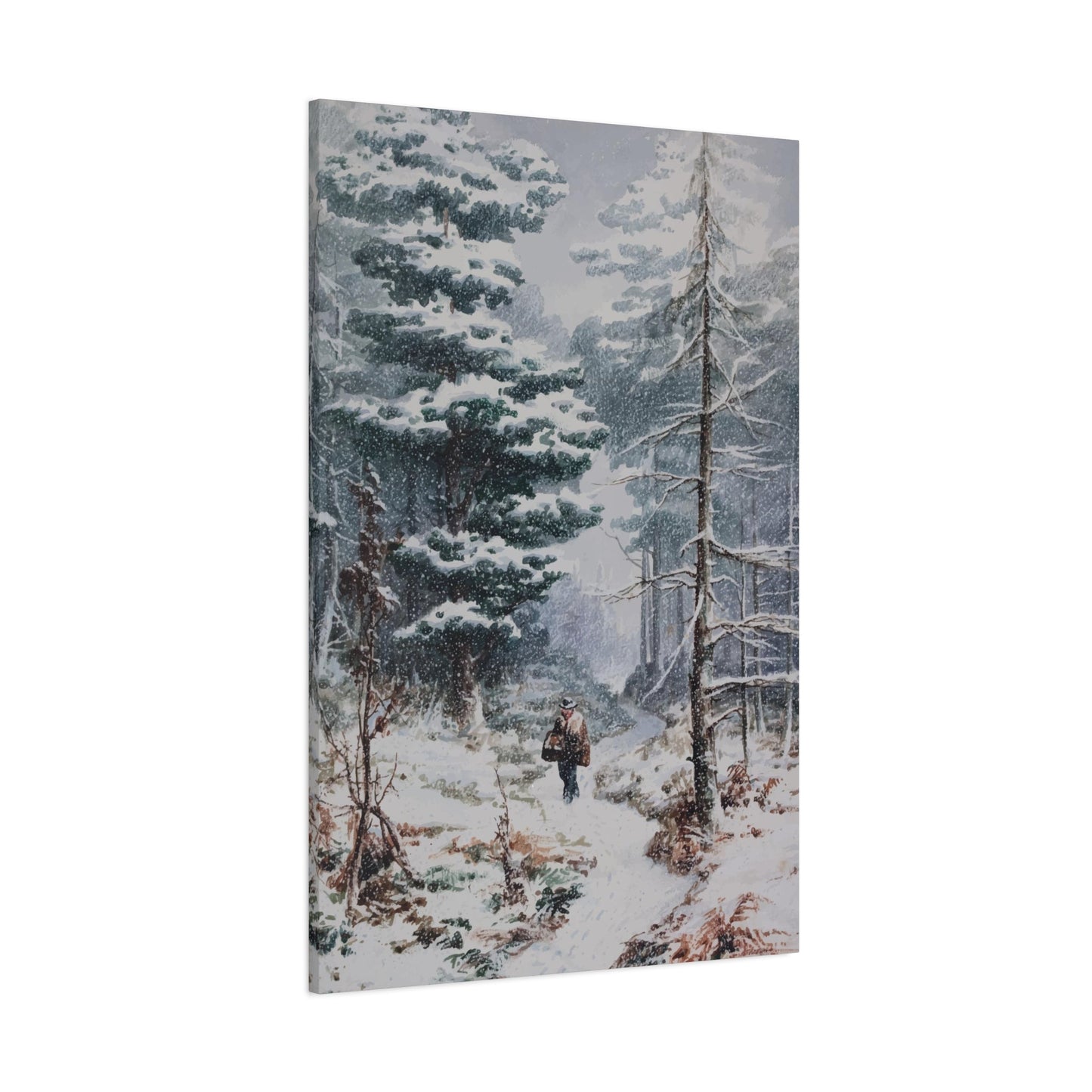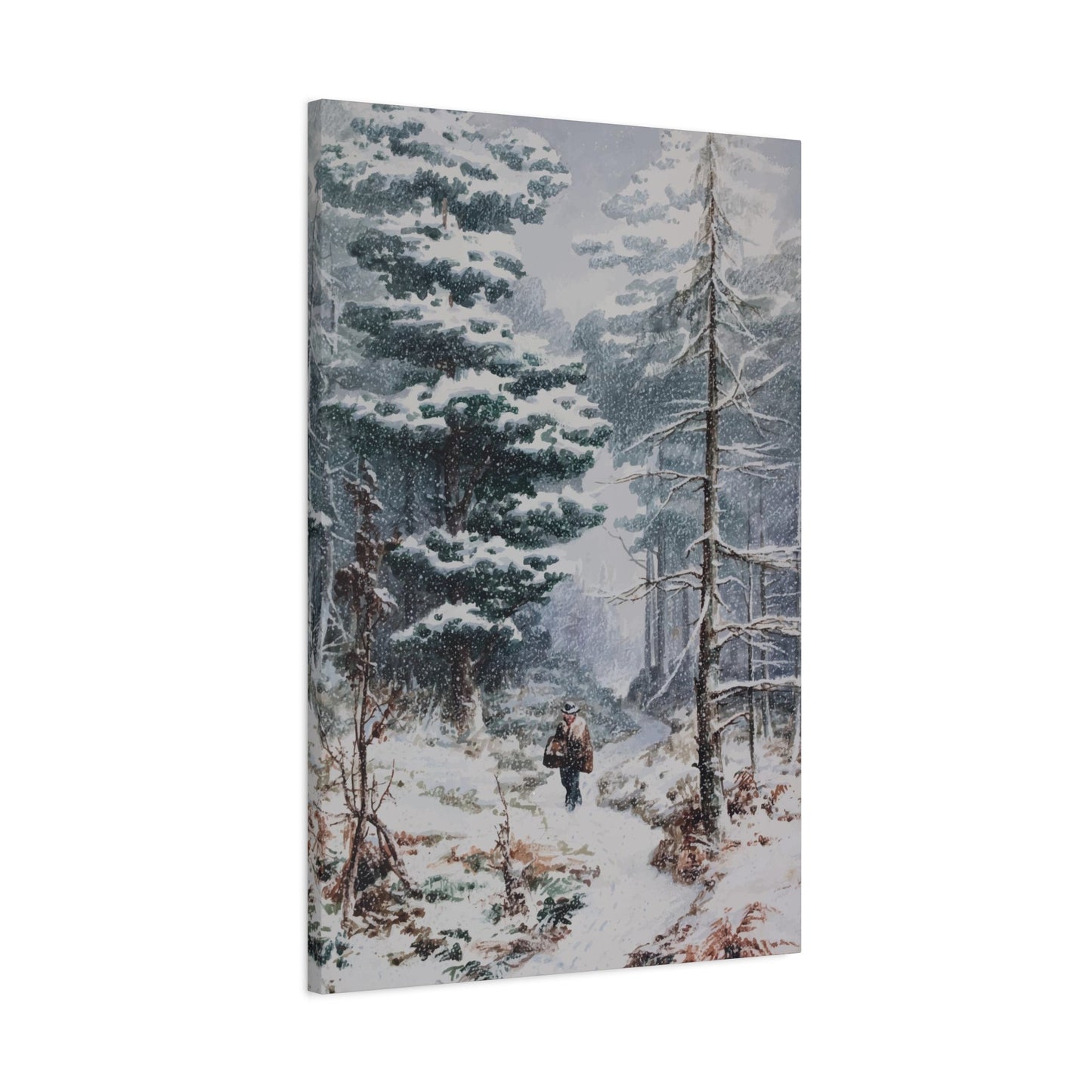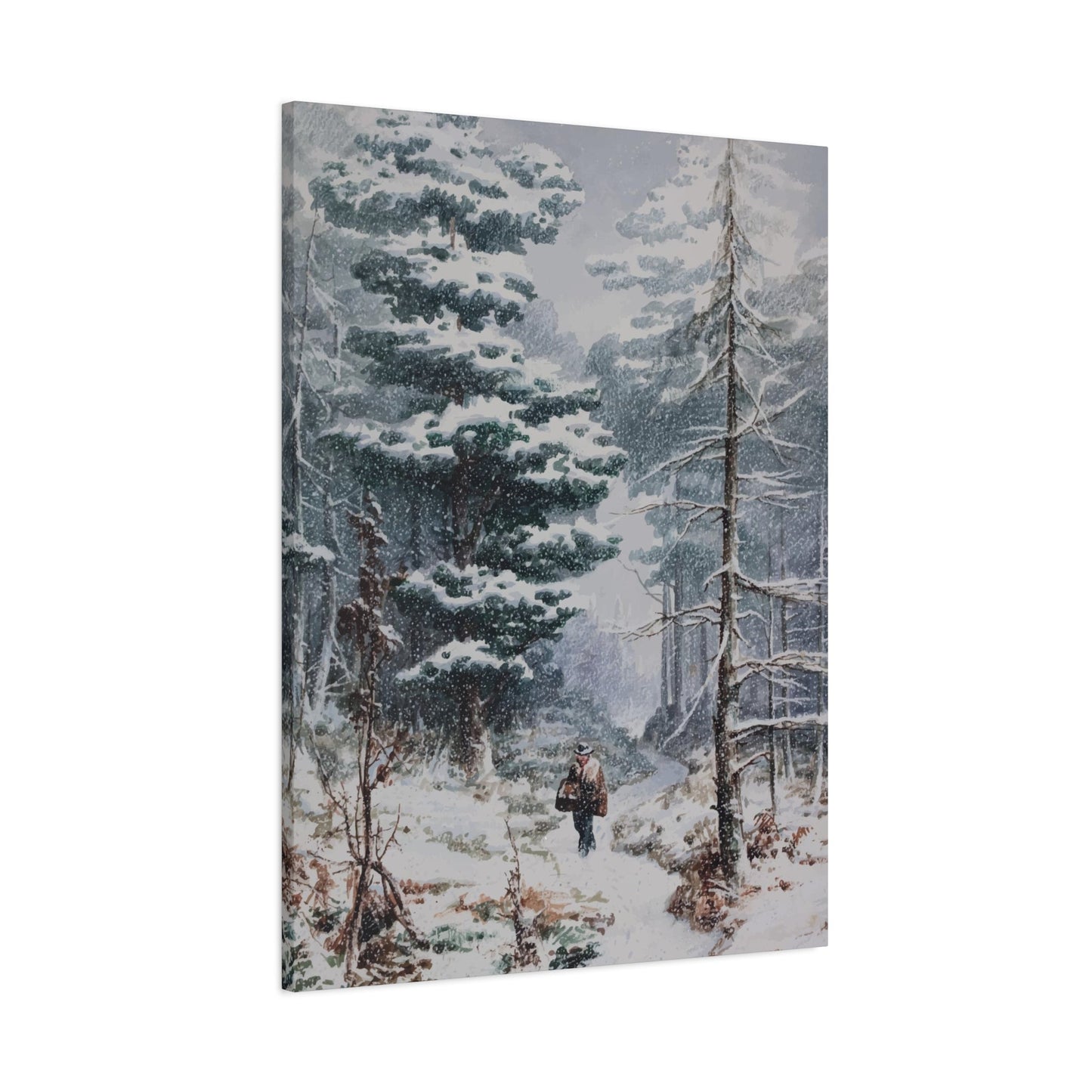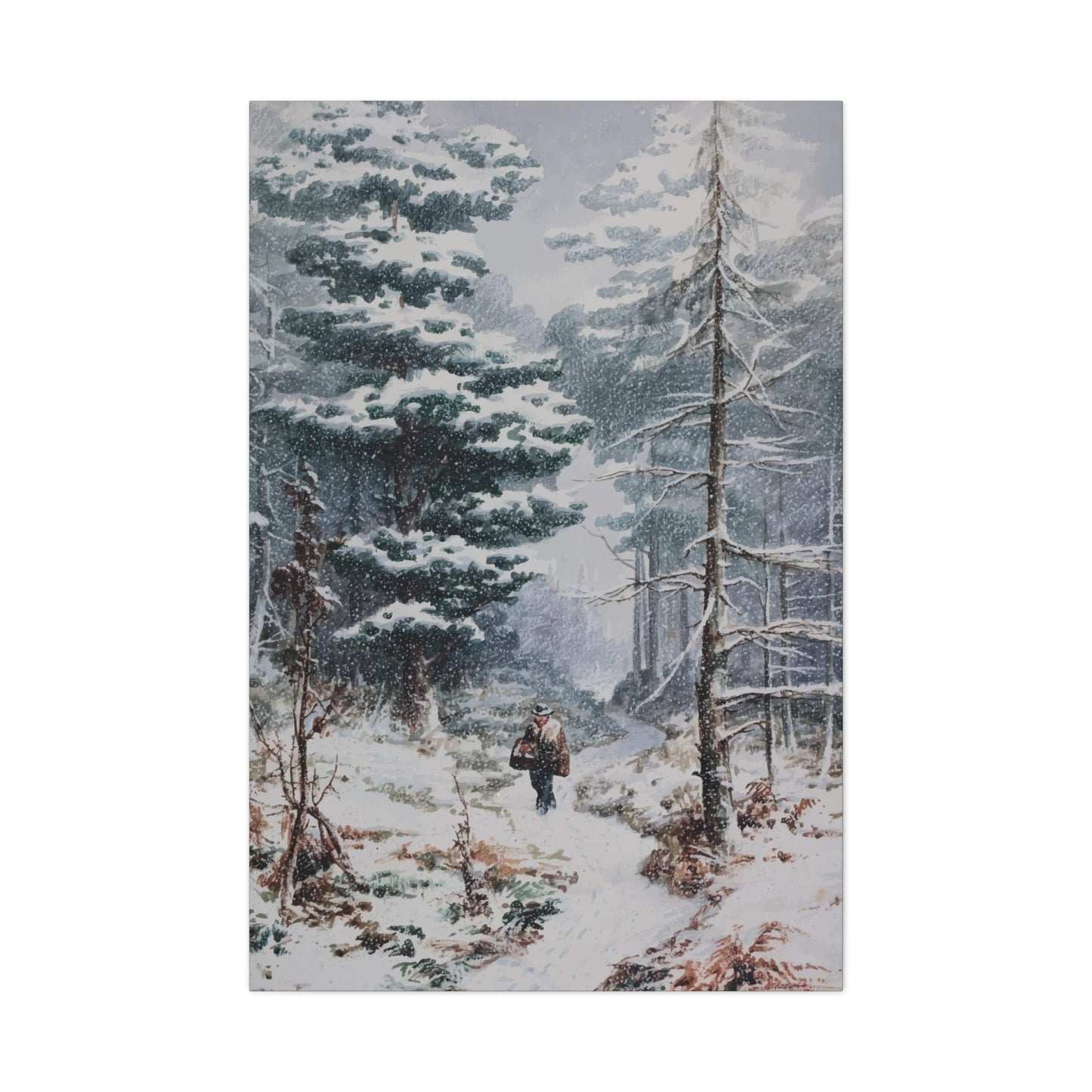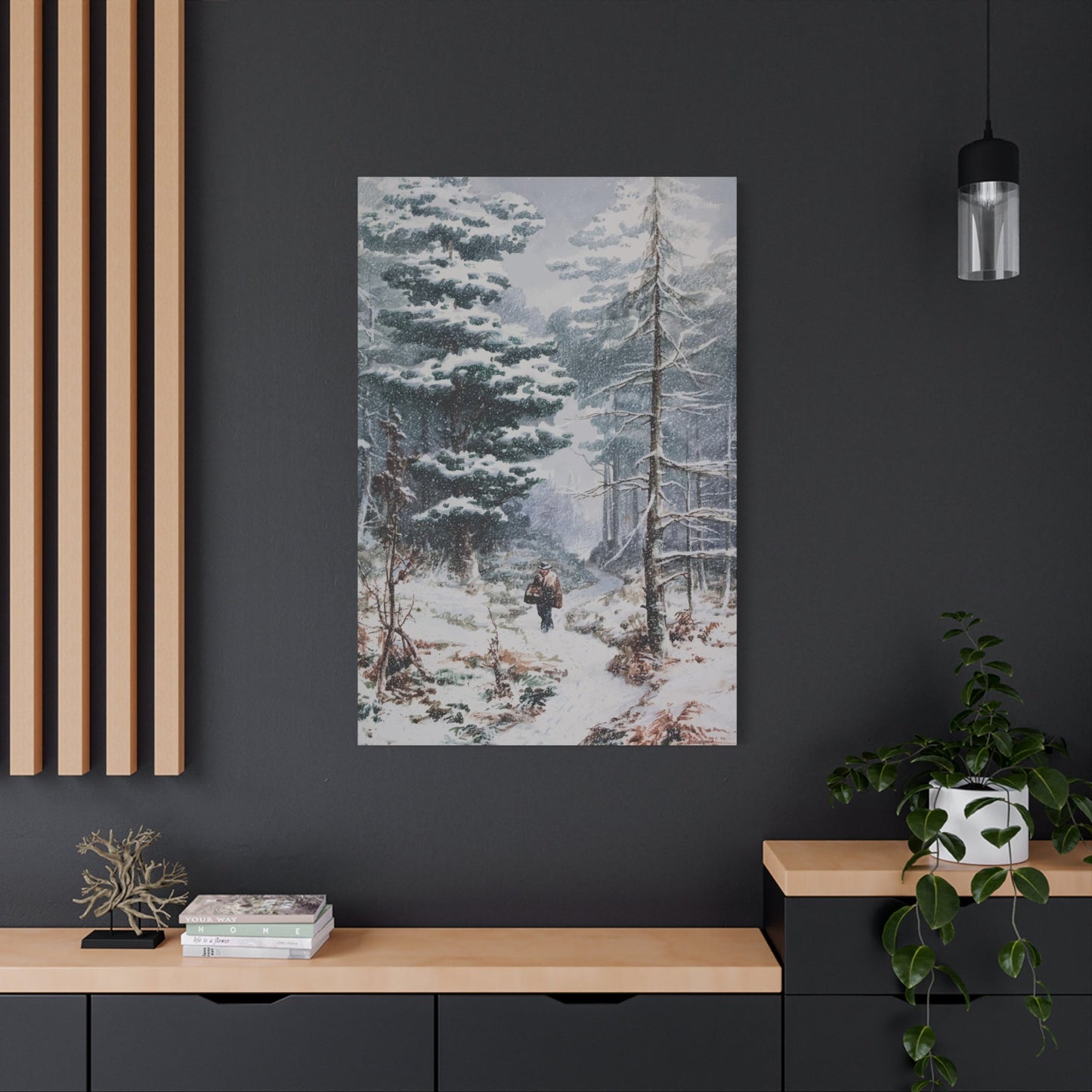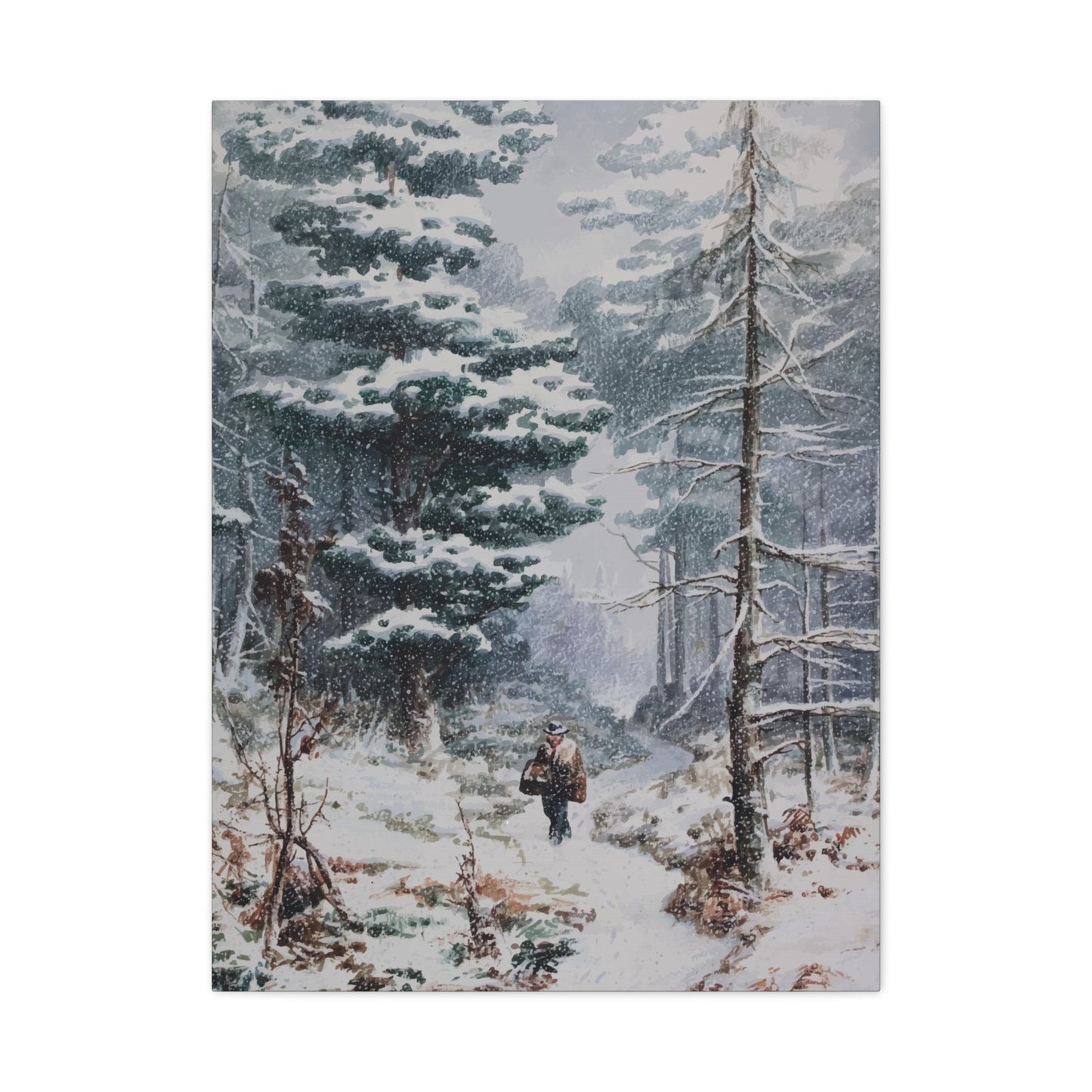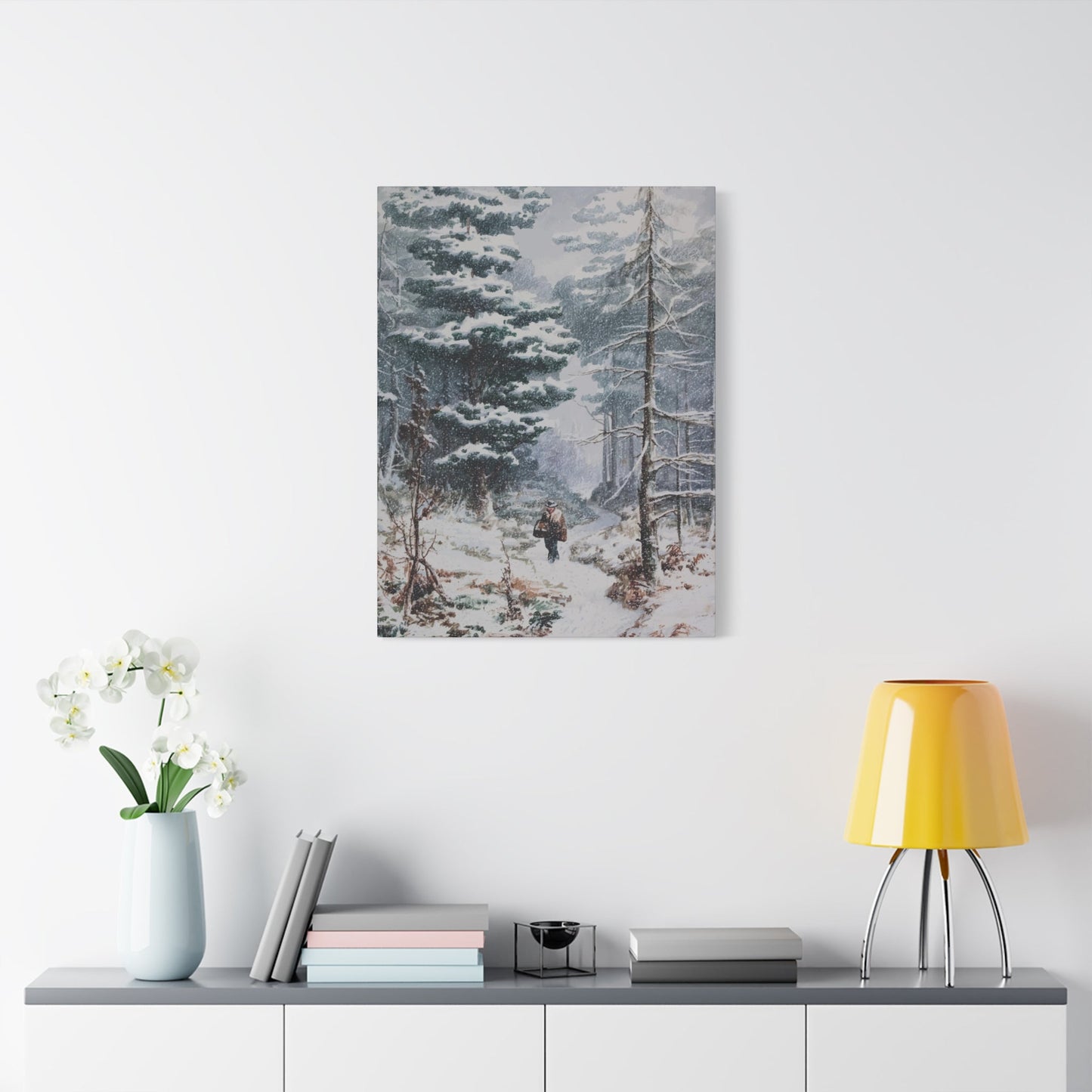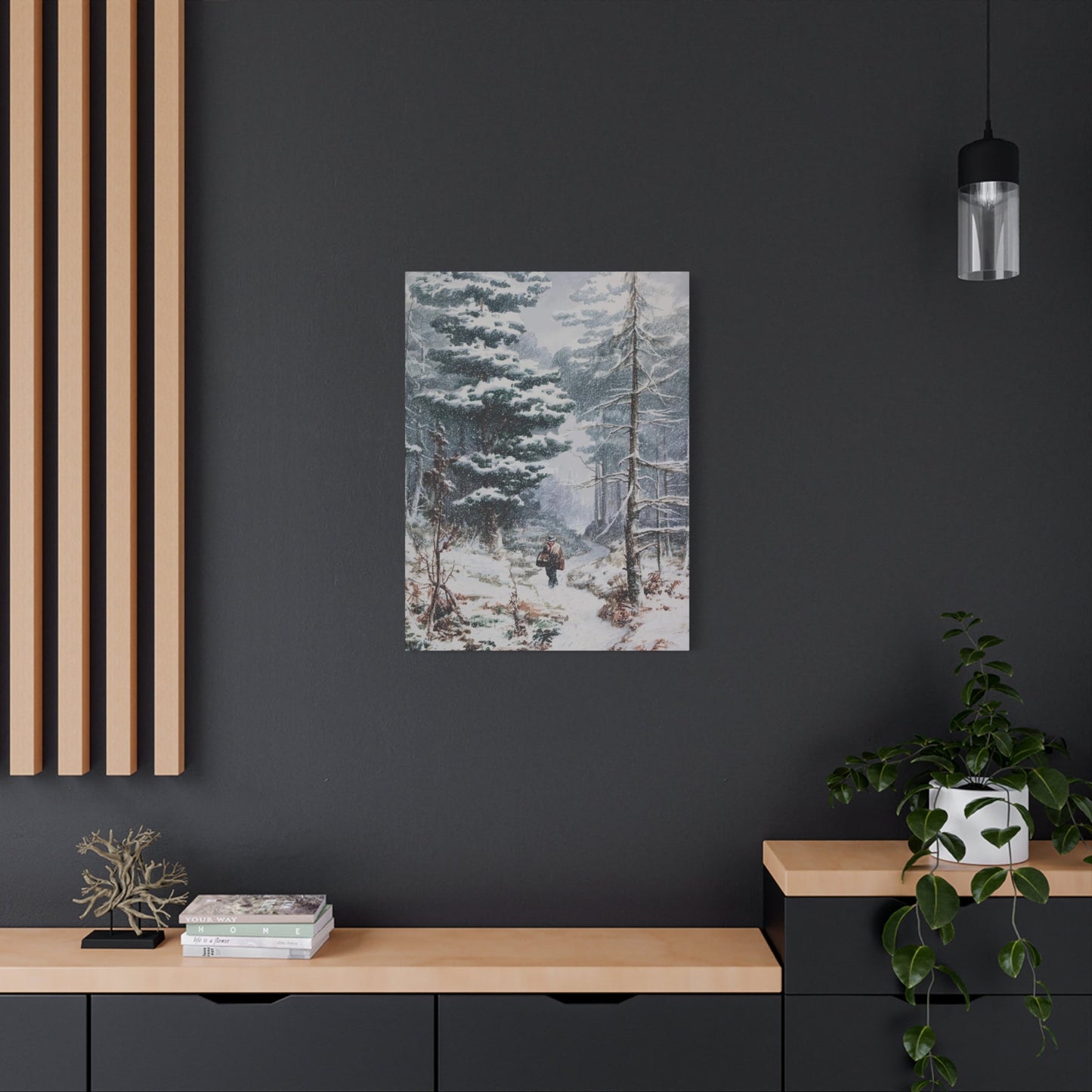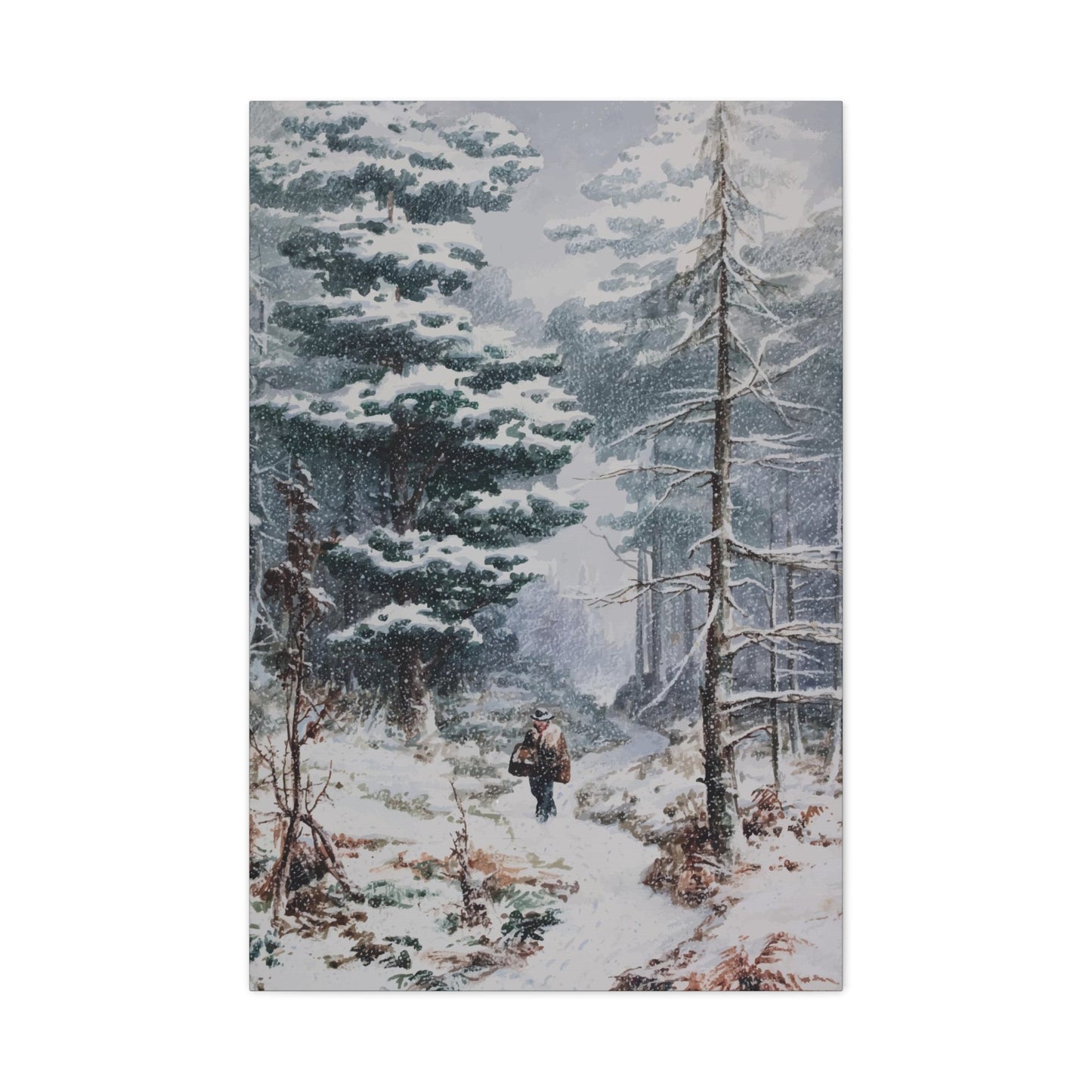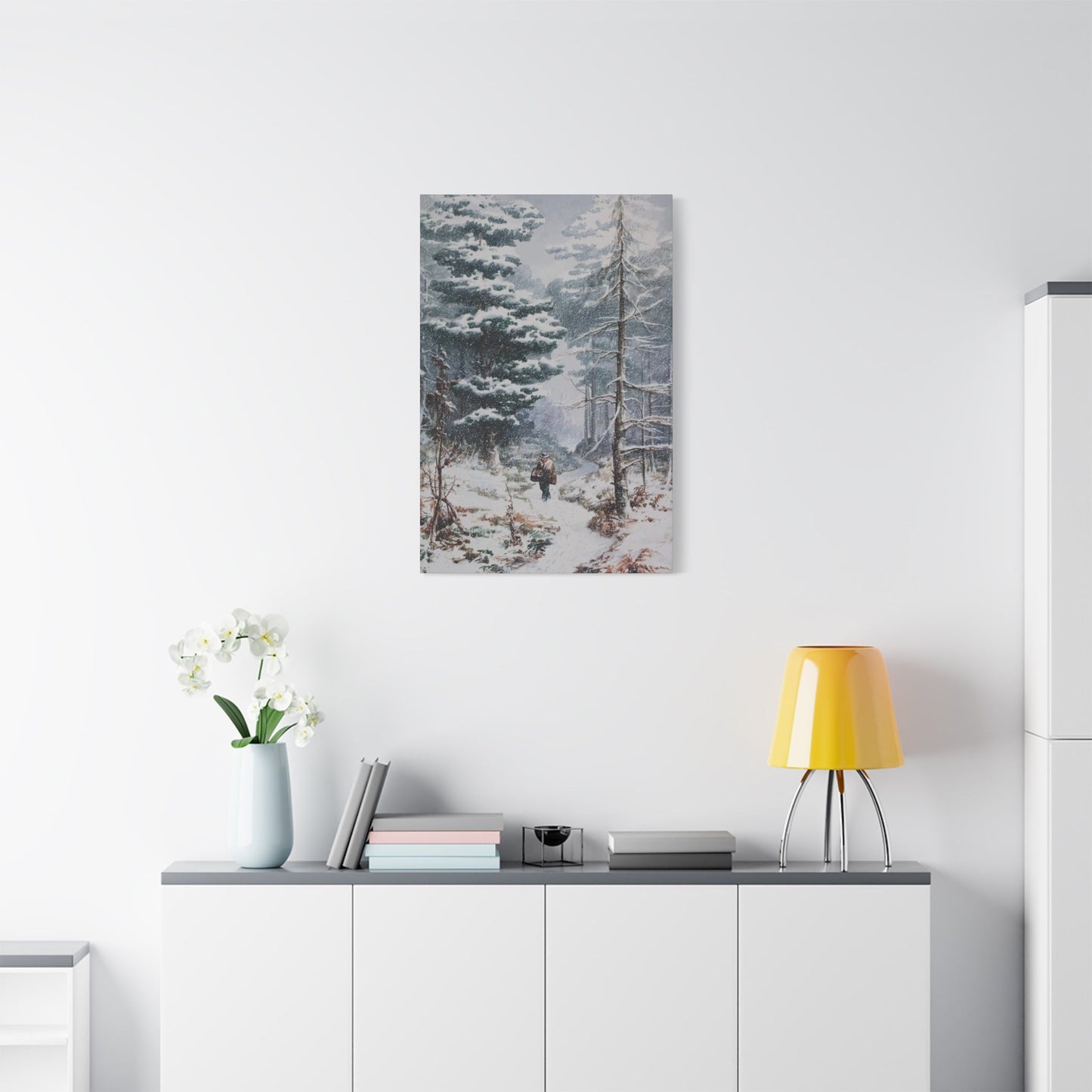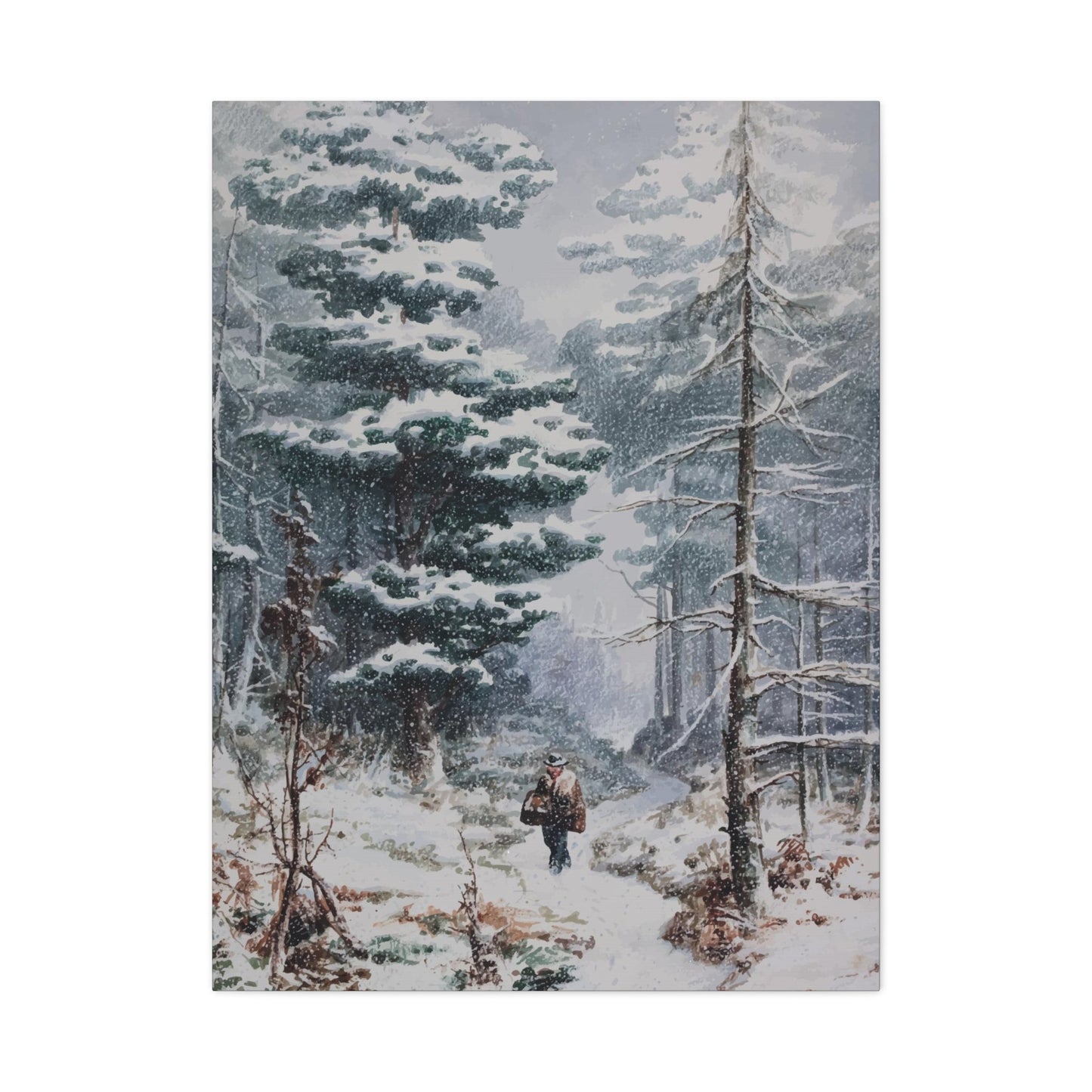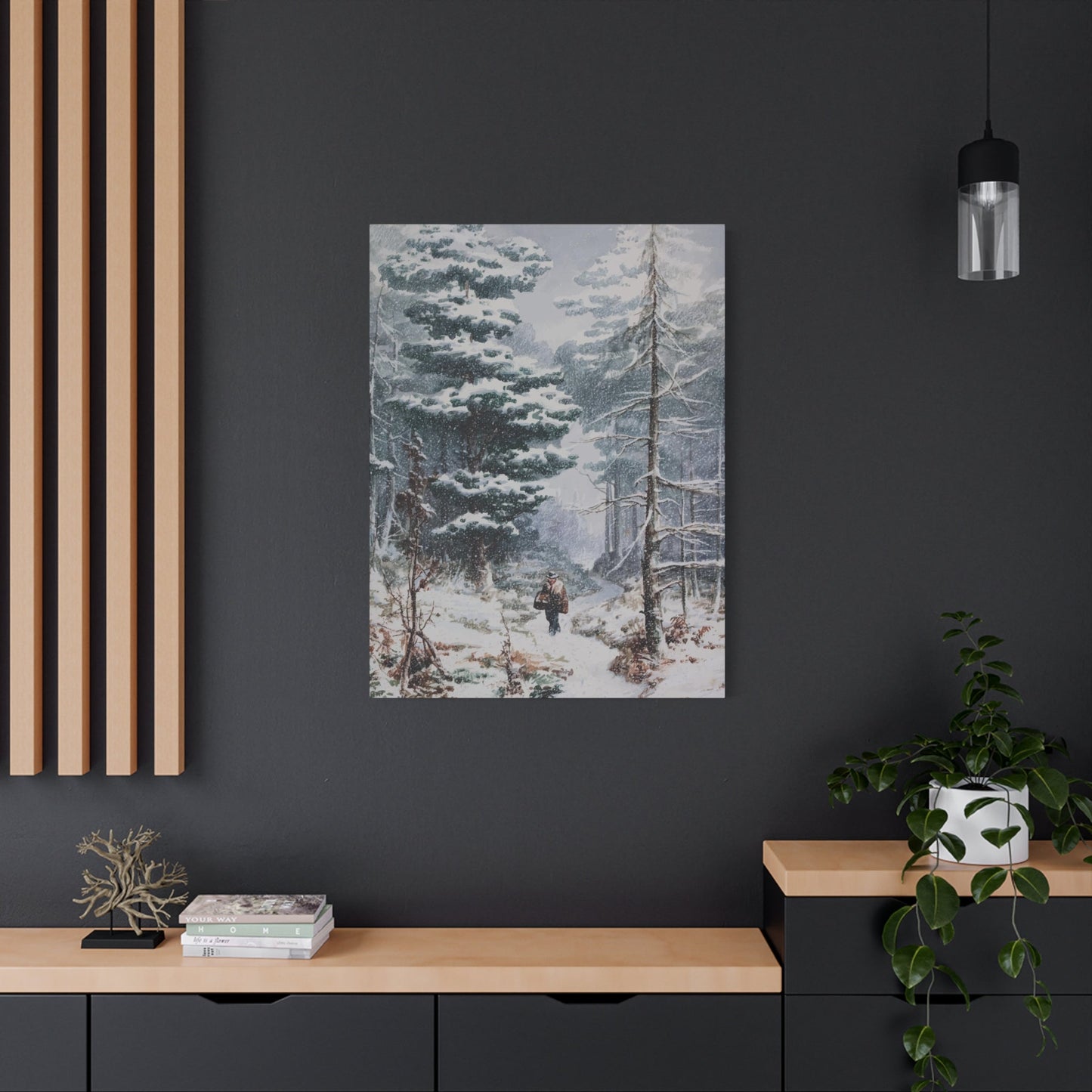Winter’s Canvas: Capturing the Beauty of Snow Around Wall Art
Winter brings with it a magical transformation of the natural world, where landscapes become blanketed in pristine white snow, creating scenes of breathtaking beauty and tranquility. This enchanting season has inspired artists for centuries, and today, homeowners can bring that same sense of wonder into their living spaces through carefully selected canvas prints and wall décor. The popularity of winter-themed artwork has grown tremendously as people seek to create cozy, serene environments that reflect the peaceful beauty of snowy landscapes. Whether you prefer dramatic mountain vistas, quiet forest scenes, or charming village settings, winter canvas art offers endless possibilities for transforming your interior spaces into havens of calm and beauty.
The appeal of snow-themed artwork extends far beyond simple decoration. These pieces carry with them an emotional resonance that connects us to nature's most serene moments. The soft whites, cool blues, and gentle grays that dominate winter landscapes create a color palette that can complement virtually any interior design style, from contemporary minimalism to rustic farmhouse aesthetics. Moreover, the tranquil nature of snowy scenes has been shown to promote relaxation and mindfulness, making these artworks not just visually appealing but potentially beneficial for mental well-being. As we explore the various aspects of winter canvas art throughout this comprehensive guide, you will discover how to select, display, and appreciate these beautiful pieces in ways that enhance your living environment and bring the magic of winter indoors year-round.
Capturing the Essence of Frosty Scenery Through Canvas Prints
The transformation of winter landscapes into canvas art requires both technical skill and artistic vision to capture the subtle nuances that make snowy scenes so captivating. Artists who specialize in winter imagery must master the challenge of depicting white snow in all its complexity, understanding that what appears as simple white actually contains countless shades of blue, gray, lavender, and even hints of pink depending on the light and time of day. The interplay of light and shadow on snow-covered surfaces creates depth and dimension that skilled artists can translate onto canvas, resulting in prints that feel alive with the crisp, clean energy of winter. Photography-based canvas prints offer their own unique advantages, capturing real moments in nature with stunning clarity and detail that can transport viewers directly into the scene. Whether created through traditional painting techniques or modern photographic methods, quality winter canvas prints preserve the ephemeral beauty of snow in a permanent form that can be enjoyed throughout all seasons.
The process of selecting canvas prints that truly capture the essence of winter requires consideration of multiple factors beyond just the subject matter. The quality of the canvas material itself plays a crucial role in how the artwork will appear and endure over time. Premium canvas materials provide better color reproduction, allowing the subtle tones of winter scenes to be displayed with accuracy and richness. The printing technique used also significantly impacts the final result, with giclée printing being considered the gold standard for art reproduction due to its ability to produce gallery-quality images with exceptional color accuracy and longevity. When evaluating potential canvas prints for your space, examine how well the piece captures the atmospheric qualities of winter, such as the softness of falling snow, the clarity of cold air, or the quiet stillness that characterizes winter landscapes. The most effective winter canvas prints do more than simply show a snowy scene; they evoke the feeling of being present in that moment, experiencing the profound peace and beauty that winter brings to the natural world.
Creating Atmospheric Spaces with Icy Landscape Wall Décor
Transforming your interior spaces with winter-themed wall décor involves more than simply hanging a picture on a wall. It requires thoughtful consideration of how the artwork interacts with the room's existing elements, including color scheme, furniture, lighting, and overall aesthetic direction. Snowy landscape art has a unique ability to create atmosphere and mood within a space, and understanding how to harness this power can dramatically enhance your living environment. The cool color palette typical of winter scenes can serve multiple purposes in interior design: it can create a sense of calm and tranquility in spaces meant for relaxation, provide a refreshing visual contrast in rooms with warmer color schemes, or reinforce a cohesive cool-toned design throughout a space. The key to successfully incorporating winter landscape wall décor lies in understanding the relationship between the artwork and its surroundings, ensuring that each piece enhances rather than conflicts with the room's overall design.
The placement of winter canvas art within a room can significantly impact its effectiveness in creating the desired atmosphere. Large-scale winter landscape prints work exceptionally well as focal points in living rooms, dining areas, or master bedrooms, commanding attention and setting the tone for the entire space. In these applications, the artwork should be positioned at eye level, typically with the center of the piece approximately 57 to 60 inches from the floor, which is the standard height used in art galleries. Smaller winter scenes can be grouped together to create gallery walls that tell a visual story of the season, combining various perspectives from wide panoramic views to intimate close-ups of snow-laden branches or frost patterns. Consider the viewing distance when selecting and placing winter artwork; pieces that will be viewed from across a room benefit from bold compositions and clear subject matter, while artwork in smaller spaces or areas where viewers will be closer can feature more intricate details and subtle elements that reward closer inspection. The lighting in the room also plays a crucial role, as natural light can change throughout the day, altering how colors and details appear in the artwork, while artificial lighting should be positioned to enhance rather than create glare on the canvas surface.
Designing with Frost-Kissed Nature in Modern Interiors
The integration of winter-themed canvas art into contemporary interior design presents exciting opportunities to create spaces that feel both current and timeless. Modern design principles emphasize clean lines, uncluttered spaces, and carefully curated decorative elements, making the selection of wall art particularly important. Winter landscapes naturally align with many modern aesthetic preferences, offering the simplicity and serenity that contemporary spaces often seek to achieve. The minimal color palette of winter scenes, dominated by whites, grays, and blues, complements the neutral foundations common in modern interiors while providing visual interest through natural forms and atmospheric effects.
When incorporating winter canvas prints into modern spaces, consider how the artwork's composition relates to the architectural elements of the room. Horizontal panoramic winter scenes can echo the long, low lines of modern furniture, while vertical compositions of tall trees or mountain peaks can draw the eye upward, emphasizing ceiling height and creating a sense of spaciousness.The frame selection for winter canvas prints in modern settings deserves careful attention, as the frame serves as the transition point between the artwork and the surrounding space. Floating frames, which create a small gap between the canvas edge and the frame, are particularly popular in contemporary interiors because they give the artwork a light, airy appearance that seems to hover on the wall.
This framing style works especially well with winter scenes, as the floating effect can enhance the ethereal quality of snowy landscapes. Alternatively, frameless gallery-wrapped canvases, where the image continues around the edges of the stretcher bars, offer a sleek, minimalist presentation that puts full focus on the artwork itself. The choice between matte and glossy finishes also impacts how winter canvas art appears in modern settings. Matte finishes tend to be preferred in contemporary interiors because they eliminate glare and reflections, allowing the artwork to be viewed clearly from any angle, while also contributing to a sophisticated, gallery-like atmosphere. The texture of the canvas itself adds another dimension to the artwork, with some prints featuring enhanced texture that mimics the appearance of original paintings, creating additional visual and tactile interest within clean, modern spaces.
Bringing Mountain Majesty into Your Living Spaces
Mountain landscapes covered in winter snow represent some of the most dramatic and awe-inspiring subjects for canvas art, offering viewers a connection to the grandeur and power of nature. These majestic scenes typically feature towering peaks crowned with snow, dramatic rock faces, and expansive vistas that convey both the beauty and the raw force of alpine environments. The appeal of mountain-themed winter canvas prints extends across various interior design styles, from rustic lodge aesthetics to sleek contemporary spaces, making them versatile choices for many homes. The scale and drama inherent in mountain imagery make these pieces particularly effective as statement artworks that anchor a room's design, drawing the eye and commanding attention in ways that can elevate the entire space.
When selecting mountain landscape canvas prints, consider not only the visual impact of the scene but also the emotional resonance it creates, as these powerful images often evoke feelings of adventure, freedom, and connection to the natural world.The composition of mountain landscape artwork plays a crucial role in its effectiveness within an interior space. Wide panoramic views that capture entire mountain ranges work beautifully in spaces with ample wall area, such as above sofas, beds, or dining tables, where their horizontal orientation complements the furniture arrangement below. These expansive compositions create a sense of openness and can make rooms feel larger by drawing the eye across the width of the wall. Alternatively, compositions that emphasize the vertical drama of individual peaks or mountain faces can add height to a room, making ceilings appear taller and creating a more dynamic visual presence.
The foreground elements in mountain winter scenes also deserve consideration, as they provide depth and scale to the composition. Images that include evergreen trees, rocky outcroppings, or frozen streams in the foreground create layers within the scene that guide the viewer's eye through the landscape, while also providing textural contrast to the smooth, snow-covered slopes. The lighting captured in mountain winter scenes significantly impacts their mood and energy, with sunrise and sunset images offering warm golden and pink tones that can soften the cool palette of snow, while overcast or twilight scenes maintain a more mysterious, contemplative atmosphere that emphasizes the serene aspects of winter mountains.
Embracing Simplicity with Understated Winter Canvas Art
The minimalist approach to winter canvas art focuses on stripping away unnecessary elements to reveal the essential beauty of snowy landscapes in their purest form. This aesthetic philosophy aligns perfectly with winter's natural tendency to simplify the visual landscape, covering complex terrain under blankets of white and reducing color palettes to their most basic components. Minimalist winter canvas prints often feature sparse compositions with plenty of negative space, allowing the eye to rest and the mind to find calm in the simplicity of the scene. These pieces might showcase a single snow-covered tree against a white sky, a subtle gradient of blue-gray winter clouds, or the gentle contours of snow drifts unmarked by footprints or other distractions.
The power of minimalist winter art lies in what it suggests rather than what it explicitly shows, inviting viewers to complete the scene with their imagination and personal experience of winter's quiet beauty.Incorporating minimalist winter canvas prints into your home requires an understanding of how simplicity in art interacts with the surrounding environment. These pieces work exceptionally well in spaces that embrace clean, uncluttered design principles, where their restraint harmonizes with the overall aesthetic approach. However, they can also provide a welcome visual respite in more eclectic or busy interiors, offering a point of calm and focus amid more complex surroundings.
The size of minimalist winter prints should be carefully considered in relation to the space; contrary to what might be assumed, minimalist artwork often benefits from being displayed at a generous scale, as this allows the subtle details and tonal variations to be properly appreciated while also giving the negative space the room it needs to create its intended effect. When displaying multiple minimalist winter pieces, maintain consistent spacing and alignment to reinforce the orderly, intentional nature of the minimalist aesthetic. The framing of minimalist winter canvas art should follow the same principle of simplicity, with clean-lined frames in neutral colors or frameless presentations that allow the artwork to speak for itself without decorative interruption.
Discovering Charm in Frost-Covered Village Scenes
Winter village scenes represent a distinct category within snowy landscape art, offering a human element that connects natural winter beauty with the warmth and comfort of community and home. These charming compositions typically feature clusters of houses or buildings blanketed in snow, often with inviting details like glowing windows, smoke rising from chimneys, or paths cleared through the snow that suggest human activity and presence. The appeal of village winter scenes lies in their ability to evoke nostalgia and a sense of coziness, transporting viewers to imagined places where life moves at a gentler pace and communities gather together against the cold. Artists who create village winter scenes must balance the pristine beauty of the snow-covered landscape with the warmth and character of human habitation, creating compositions that feel both peaceful and welcoming.
These scenes resonate particularly strongly during the winter holiday season but maintain their appeal throughout the year as symbols of comfort, community, and the enduring human spirit that thrives even in the coldest months.The architectural elements in village winter scenes contribute significantly to their character and appeal. Traditional cottages with steep, snow-laden roofs, small churches with tall steeples reaching toward winter skies, and rustic barns weathered by countless seasons all serve as focal points that anchor these compositions. The arrangement of buildings within the scene creates visual rhythm and guides the viewer's eye through the artwork, with winding streets or paths often leading deeper into the composition, inviting exploration and engagement with the scene. The treatment of light in village winter artwork is particularly important for creating the warm, inviting atmosphere that makes these pieces so appealing.
Evening scenes with warm light glowing from windows create strong visual contrast against the cool blues and whites of the snow, emphasizing the theme of warmth and shelter from winter's cold. The inclusion of small details like footprints in the snow, parked sleighs or vehicles, garden fences peeking through snowdrifts, or evergreen wreaths on doors adds layers of storytelling to village scenes, making them more engaging and allowing viewers to imagine the lives and activities of the unseen inhabitants. When selecting village winter canvas prints for your home, consider how the scale and setting of the depicted village relates to your own environment and preferences; some may prefer the quiet intimacy of a small hamlet nestled in the mountains, while others might be drawn to more bustling winter town scenes with multiple buildings and suggested activity.
Transforming Rooms with Woodland Winter Imagery
Forest and woodland scenes covered in winter snow offer some of the most tranquil and meditative subjects for canvas art, capturing the profound stillness and natural beauty of trees in their winter dormancy. These compositions draw viewers into quiet worlds of vertical lines created by tree trunks, delicate branch patterns stark against winter skies, and the soft, undisturbed snow that blankets the forest floor. The appeal of woodland winter imagery extends beyond simple aesthetics to touch something deeper in our psychological connection to forests as places of mystery, contemplation, and renewal. Trees have long held symbolic significance across cultures, representing growth, endurance, and the cycles of life, and their winter appearance, stripped of leaves and covered in snow, emphasizes themes of rest, patience, and the quiet strength needed to endure challenging seasons.
Canvas prints featuring winter forests work beautifully in spaces meant for relaxation and reflection, such as bedrooms, reading nooks, home offices, or meditation areas, where their calming influence can be fully appreciated.The composition of woodland winter artwork varies widely depending on the artist's approach and the specific mood they wish to convey. Dense forest scenes where trees fill the frame create a sense of enclosure and intimacy, drawing viewers into a private world removed from external concerns. These compositions often use depth of field to create layers, with sharp foreground trees gradually softening as the forest recedes into misty backgrounds, suggesting the quiet mystery of winter woods. Alternatively, more open woodland compositions featuring fewer trees with more space between them convey a different feeling, emphasizing the individual character of each tree while creating a sense of spaciousness and breathing room.
The type of trees depicted also significantly impacts the scene's character; evergreens heavily laden with fresh snow create dramatic visual weight and suggest the height of winter, while bare deciduous trees reveal intricate branch patterns that create delicate tracery against sky or snow. Birch trees with their distinctive white bark offer particularly striking subjects for winter canvas art, as their natural coloring harmonizes beautifully with snow while their dark markings provide visual contrast and interest. The lighting in woodland winter scenes ranges from the soft, diffused illumination of overcast days that emphasizes the quiet contemplative mood of winter forests, to dramatic sidelight that creates strong shadows and highlights the texture of bark and snow, or the magical quality of light filtering through trees during sunrise or sunset.
Achieving Balance with Peaceful Snowy Landscape Art
The concept of tranquility in winter canvas art revolves around creating compositions that communicate peace, stillness, and harmony through careful attention to visual elements and emotional tone. Peaceful winter landscapes typically avoid dramatic contrasts or chaotic elements, instead focusing on gentle transitions, balanced compositions, and subjects that inherently convey calmness. These might include unbroken expanses of fresh snow, calm winter lakes with mirror-like surfaces reflecting surrounding scenery, gently rolling hills under winter skies, or quiet meadows where nothing disturbs the pristine snow. The color palette in tranquil winter artwork tends toward soft, muted tones rather than bold contrasts, with gentle gradations between subtle shades of white, cream, pale blue, and soft gray creating a soothing visual experience.
The absence of human figures or signs of activity in many peaceful winter scenes reinforces their contemplative nature, allowing viewers to project themselves into the quiet beauty of the landscape without the distraction of narrative elements.Creating a sense of tranquility through winter canvas art in your home involves both the selection of appropriate artwork and its thoughtful placement within your living spaces. Bedrooms benefit particularly from peaceful winter landscapes, as their calming influence can promote relaxation and better sleep quality. In these intimate spaces, consider positioning the artwork where it will be visible from the bed, allowing the serene scene to be among the last things you see before sleep and the first upon waking.
Living rooms and family areas can also benefit from tranquil winter artwork, providing a visual anchor that promotes calm amid the busy activities of daily life. When incorporating peaceful winter scenes into active spaces, consider creating a dedicated viewing area where you can sit quietly and appreciate the artwork, perhaps with comfortable seating positioned to face the piece, creating a mini-retreat within your home. The size of tranquil winter canvas prints should be proportional to the space and the desired impact; larger pieces can envelop viewers in the scene's calmness, while smaller works can offer intimate moments of peace without overwhelming the space. Multiple peaceful winter scenes can be displayed together to create a cohesive atmosphere, but maintain consistent styling and spacing to avoid creating visual clutter that would contradict the tranquil nature of the individual pieces.
Exploring Dramatic Ice and Snow Artistic Compositions
While many winter canvas prints emphasize peace and serenity, another category embraces the dramatic, powerful aspects of winter weather and frozen landscapes. These bold compositions capture winter in its most intense manifestations, featuring subjects like ice formations, blizzard conditions, crashing frozen waves, massive icicles, or snow-laden trees bent under the weight of accumulation. The appeal of dramatic winter art lies in its ability to convey the raw power of nature and the remarkable beauty that emerges from extreme conditions. These pieces often feature strong contrasts between light and dark, sharp lines and angles in ice formations, or dynamic compositions that suggest movement and energy despite the frozen subject matter.
Dramatic winter canvas prints work particularly well in contemporary spaces where bold artwork is needed to make a statement, or in rooms with strong architectural features that can hold their own against powerful imagery. The emotional impact of dramatic winter scenes differs significantly from peaceful landscapes, evoking feelings of awe, respect for nature's power, and appreciation for the fierce beauty that emerges from harsh conditions.The technical aspects of capturing dramatic winter conditions in canvas art require skill and often perfect timing on the part of photographers or careful observation and technique from painters. Ice formations, in particular, present fascinating subjects with their translucent qualities, internal structures, and the way they interact with light.
Canvas prints that showcase close-up views of ice reveal intricate patterns, bubbles, cracks, and layering that most people never have the opportunity to observe closely in nature. These abstract qualities make ice-focused winter art particularly suitable for modern interiors where the interplay between natural forms and abstract beauty is appreciated. Frozen waterfalls represent another dramatic winter subject, where the motion of flowing water is captured in mid-cascade, creating surreal sculptures of ice that hang suspended from rock faces. The contrast between the frozen state and the implied movement of water creates visual tension that engages viewers and draws them into closer examination of the artwork. Snow-laden trees bent into dramatic curves by the weight of accumulated snow demonstrate both the force of winter weather and the resilience of nature, creating compositions with strong diagonal lines and organic forms that add dynamic energy to interior spaces.
Understanding Color Theory in Winter Canvas Selection
The color palette of winter landscapes offers unique opportunities and considerations for interior design, as the naturally muted and cool tones can be leveraged to create specific atmospheric effects within living spaces. Understanding color theory as it relates to winter canvas art helps in selecting pieces that will harmonize with existing décor while achieving desired emotional and aesthetic outcomes. The dominant whites and off-whites in winter scenes serve as neutral foundations that can actually contain warm or cool undertones depending on lighting conditions and surrounding colors. Snow photographed or painted during golden hour may have warm peachy or yellow undertones, while snow in shadow or under overcast skies will lean toward blue or lavender.
These subtle temperature variations within the white areas of winter canvas prints can significantly impact how the artwork interacts with room colors. Cool-toned winter pieces with blue and gray dominance can create refreshing contrast in rooms with warm color schemes featuring browns, oranges, or warm grays, while they reinforce and expand the sense of coolness in rooms already decorated in blues, silvers, or cool grays.The limited color range in winter canvas art should not be mistaken for lack of color sophistication; in fact, the subtle variations within a narrow palette often create more nuanced and refined visual experiences than artwork with bold, contrasting colors. The best winter landscape prints demonstrate masterful handling of value, which refers to the relative lightness or darkness of colors, creating depth and dimension through careful gradations rather than through color contrast.
When evaluating winter canvas prints, observe how many distinct values you can identify within what might initially appear as simple white snow; quality winter artwork will show multiple levels of light and shadow, creating form and texture that bring the scene to life. The accent colors in winter landscapes, though often minimal, play crucial roles in composition and mood. The warm browns of tree bark, the deep greens of evergreen foliage, the rust tones of dried grasses poking through snow, or the warm glow of sunset or sunrise all provide important counterpoints to the cool dominance of winter scenes. These color accents can be echoed in room décor through throw pillows, blankets, or decorative objects, creating visual connections between the artwork and the space that make the overall design feel cohesive and intentional.
Incorporating Seasonal Themes Throughout the Year
One consideration when investing in winter canvas art is how these pieces will function within your home throughout all seasons, as most people prefer artwork that remains relevant and appealing year-round rather than requiring seasonal rotation. The good news is that quality winter landscape canvas prints possess timeless appeal that transcends seasonal specificity, offering beauty and visual interest regardless of the weather outside your windows. The key to selecting winter artwork that works all year lies in understanding the emotional and aesthetic qualities you want the piece to provide. If you are drawn to winter scenes primarily for their sense of peace and calm, these qualities remain valuable and relevant in every season.
Similarly, if you appreciate the clean, minimalist aesthetic of snowy landscapes, this design sensibility continues to complement modern interiors throughout the year. The contrast between winter artwork and warmer seasons can actually become an asset, providing visual refreshment during summer months and a year-round connection to nature's cycles and diversity.Strategic placement of winter canvas art can maximize its year-round effectiveness within your home. In climate-controlled interior spaces without views to outdoor seasonal changes, winter artwork maintains constant relevance without the potential disconnect that might occur in a room with large windows showing blooming spring gardens or autumn foliage. Rooms used primarily in the evening, when outdoor conditions are less visible, also provide ideal settings for winter canvas prints, as the artwork stands on its own without competing with seasonal outdoor views.
Some homeowners embrace seasonal décor rotation, swapping winter canvas prints for other nature scenes throughout the year, but this approach requires storage space and the effort of making changes. A middle ground involves maintaining winter canvas art as permanent installations while adjusting surrounding décor elements seasonally; for example, pairing winter landscape artwork with cool-toned pillows and throws during warmer months, then adding warm, cozy textures in autumn and winter to create seasonal shifts without changing the artwork itself. The sophisticated, neutral palette of winter landscapes also makes them excellent foundations for seasonal décor changes, as they provide a stable backdrop that accommodates various accent colors and styling approaches throughout the year.
Selecting the Right Scale for Maximum Impact
The size of winter canvas art relative to both the wall space and the room dimensions significantly impacts the piece's effectiveness and the overall aesthetic result. Selecting appropriately scaled artwork is one of the most important decisions in creating a successful interior design, yet it is also one of the most commonly mishandled aspects of home décor. Many people default to choosing artwork that is too small for the available space, resulting in pieces that appear tentative or lost on large walls, failing to create the intended impact. Understanding the principles of scale helps ensure that winter canvas prints command appropriate visual weight and create the desired atmosphere within each space.
As a general guideline, artwork hung above furniture should span approximately two-thirds to three-quarters the width of the furniture piece below it, creating visual connection and balance between the furniture and the wall art. For a standard three-seat sofa measuring about 90 inches wide, this would suggest canvas art in the range of 60 to 67 inches wide, though this can be achieved with a single large piece or a carefully arranged group of smaller pieces.The height of rooms also influences ideal artwork proportions, as pieces that are too vertically compressed may not properly fill the visual space between furniture and ceiling, leaving awkward empty areas above the artwork. In rooms with standard 8-foot ceilings, vertical clearance is limited, making horizontal compositions generally more successful. However, rooms with 9-foot ceilings or higher can accommodate more vertical artwork that draws the eye upward and emphasizes the generous ceiling height.
Large-scale winter canvas prints, sometimes measuring 4 feet wide or larger, create dramatic statements that transform walls into windows onto snowy landscapes, immersing viewers in the scene. These impressive pieces work best in spacious rooms with sufficient viewing distance, allowing the entire composition to be taken in without requiring uncomfortable head movement. In smaller rooms or spaces where viewing distance is limited, moderately sized canvas prints prove more successful, as they can be fully appreciated from closer range. Multiple canvas panels arranged as diptychs or triptychs offer another scaling approach, dividing a single winter landscape across two or three separate canvases that hang together as a unified composition. This approach can be particularly effective for very wide wall spaces, as it allows for impressive total dimensions while breaking the image into more manageable individual panels that are easier to hang and transport.
Framing and Presentation Considerations for Winter Art
The way winter canvas prints are framed and presented significantly impacts their appearance and how they integrate into interior spaces, making frame selection an important part of the overall artwork decision. Canvas prints offer several presentation options, each with distinct aesthetic qualities and practical considerations. Gallery-wrapped canvases, where the printed image continues around the sides of the stretcher bars, allow for frameless display that creates a clean, contemporary appearance. This presentation style works particularly well with modern and minimalist interiors, as it eliminates visual boundaries between the artwork and the wall, allowing the image to float freely in space. The depth of the stretcher bars in gallery-wrapped canvases varies, with thicker options creating more three-dimensional presence and shadow effects against the wall.
When selecting gallery-wrapped winter canvas prints, ensure that the image composition works with the wrap-around presentation, avoiding pieces where important elements would be lost around the edges.Traditional framing adds formal structure and polish to canvas prints, elevating their presentation while also providing additional protection for the canvas edges. Frame selection for winter canvas art should consider both the style of the artwork and the interior design context where the piece will be displayed. Natural wood frames in lighter finishes complement the organic subject matter of winter landscapes while maintaining the cool, fresh feeling of the snowy scenes. Gray, white, and black frames offer more contemporary presentation options, with black frames creating strong definition and contrast, white frames maintaining the light, airy quality of winter scenes, and gray frames providing a sophisticated middle ground that works with many design styles.
The frame width should be proportional to the artwork size, with larger canvas prints generally benefiting from wider frames that provide substantial visual weight, while smaller pieces work well with more delicate framing that doesn't overwhelm the image. Floating frames, which leave a gap between the canvas edge and the inner frame edge, combine the clean appearance of gallery wrapping with the polish and protection of traditional frames, offering an excellent middle ground that suits many winter canvas prints. The mat board consideration typically does not apply to canvas prints as it does to paper art, though some framing approaches do incorporate mats for specific aesthetic effects, creating additional neutral space around the canvas that can help smaller pieces hold their own on larger walls.
Illuminating Winter Canvas Art for Optimal Viewing
The lighting of winter canvas art dramatically affects how the artwork appears and how successfully it fulfills its decorative and atmospheric purposes within a space. Proper illumination reveals the subtle tonal variations, delicate details, and textural qualities that make winter landscapes visually compelling, while poor lighting can flatten the image, create glare, or wash out important elements. Natural light presents both opportunities and challenges for winter canvas art. Rooms with abundant natural light provide ever-changing illumination that can reveal different aspects of winter artwork throughout the day, with morning light potentially emphasizing cool tones, midday sun bringing out maximum detail and contrast, and afternoon or evening light adding warmth to the scene.
However, direct sunlight falling on canvas prints should be avoided, as prolonged UV exposure can cause fading and damage to both the canvas material and the inks or paints, compromising the artwork's longevity. Positioning winter canvas art on walls perpendicular to windows rather than directly opposite them helps maximize natural light benefits while minimizing direct sun exposure.Artificial lighting provides controlled, consistent illumination that can be specifically designed to showcase winter canvas art effectively. Picture lights mounted directly above or below artwork offer focused illumination that draws attention to the piece while minimizing glare. When selecting picture lights for winter canvas prints, consider LED options that provide bright, even illumination without generating heat that could potentially damage the artwork over time.
The color temperature of artificial lighting significantly impacts how winter canvas art appears, with warm white light adding a cozy, inviting quality that can slightly counter the cool tones of winter scenes, while daylight-balanced or cool white light maintains the authentic color palette of the snowy landscape. Track lighting or adjustable recessed lights provide flexible illumination options, allowing you to direct light precisely where needed and adjust as artwork arrangements change. When using directional lighting, position the light source to create approximately a 30-degree angle to the artwork surface, which minimizes glare while providing even illumination across the canvas. Avoid positioning lighting such that it creates hotspots or uneven illumination that draws attention to the lighting rather than the artwork. In rooms where winter canvas art serves as a primary focal point, consider placing the artwork on a dimmer switch system that allows you to adjust lighting intensity based on time of day, activities, and desired ambiance.
Creating Gallery Walls with Multiple Winter Scenes
Gallery walls featuring multiple winter canvas prints offer opportunities to create more complex and personalized displays than single pieces alone can provide, allowing you to tell visual stories and create rhythm through repetition and variation. Successfully designing gallery walls requires careful planning to achieve balance and cohesion while avoiding visual chaos. When working with winter-themed gallery walls, consider whether you want to maintain consistency across all pieces or embrace variety within the winter theme. Consistent approaches might feature multiple works by the same artist, prints of similar size and orientation, or scenes from the same geographic location, creating a unified collection that feels intentional and curated.
This approach works particularly well in formal spaces or when supporting a minimalist aesthetic. Alternatively, varied gallery walls might include different types of winter scenes, mixing mountain landscapes with forest views and village scenes, or combining various sizes, orientations, and framing styles for a more eclectic, collected-over-time appearance that adds personality and visual interest to casual spaces.The physical arrangement of multiple winter canvas prints requires attention to spacing, alignment, and overall composition to create a gallery wall that feels balanced rather than cluttered or disjointed. Begin by laying out your arrangement on the floor, experimenting with different configurations until you find a composition that feels right. Generally, maintaining consistent spacing between pieces creates the most cohesive appearance, with 2 to 3 inches between frames being a common standard that allows each piece to maintain its individual identity while contributing to the overall composition.
For gallery walls arranged in grid patterns, precise alignment is essential, with all pieces hanging at consistent heights and intervals to reinforce the orderly, intentional nature of the display. More organic arrangements that cluster pieces more loosely can accommodate different sizes and orientations more easily, but still benefit from some organizing principles, such as aligning several pieces along a common horizontal or vertical axis, or ensuring that the overall group forms a pleasing shape within the wall space. When designing gallery walls with winter canvas prints of different sizes, use your largest piece as an anchor, typically positioning it slightly off-center rather than exactly in the middle, then arrange smaller pieces around it in a balanced composition. The outer boundaries of the overall arrangement should form a relatively clean shape rather than having pieces scattered widely in an undefined manner, helping the gallery wall function as a cohesive unit rather than a collection of separate elements.
Preserving Winter Canvas Artwork
Proper care and maintenance ensure that winter canvas prints retain their beauty and visual impact for many years, protecting your investment and allowing you to continue enjoying these artworks throughout their potential decades-long lifespan. Canvas is a relatively durable material, but it does require some attention to preserve its appearance and structural integrity. Dust accumulation is the most common maintenance concern for canvas prints, as particles settle on the textured surface over time, potentially dulling the image and accumulating in the weave of the canvas. Regular gentle dusting using a soft, clean, dry cloth or a soft-bristled brush removes surface dust without risking damage to the canvas or printed image. Work with light pressure and brush or wipe in one direction rather than circular motions, which can grind dust particles into the canvas texture.
Avoid using water, cleaning solutions, or chemicals on canvas prints unless specifically recommended by the manufacturer, as these can damage the canvas material, the coating on the canvas surface, or the inks or paints that form the image.Environmental conditions in your home impact the longevity of winter canvas prints, with temperature, humidity, and light exposure being the primary factors to monitor and control. Extreme temperatures and dramatic temperature fluctuations can cause canvas to expand and contract, potentially leading to warping, loosening, or cracking of the surface over time. Maintaining moderate, consistent temperatures helps preserve canvas integrity. Humidity levels also affect canvas, with high humidity potentially causing mildew or mold growth, while extremely dry conditions can make canvas brittle. Aim for relative humidity levels between 40 and 60 percent in rooms displaying canvas art.
Light exposure, particularly UV radiation from sunlight, poses the greatest threat to canvas print longevity, causing colors to fade and materials to degrade over time. While some fading is inevitable over years of display, you can significantly slow this process by positioning canvas prints away from direct sunlight, using UV-filtering window treatments in bright rooms, and considering UV-protective glass or acrylic if framing canvas prints. If you notice that a winter canvas print has become loose or saggy on its stretcher bars, many canvases can be tightened using the wedges or keys typically included in the corners of the stretcher bar frame, though this adjustment should be done carefully to avoid over-tightening, which can cause its own problems. For valuable pieces or significant damage, professional art conservators can provide restoration services to address issues beyond basic maintenance.
Final Thoughts:
Winter’s quiet elegance and pristine beauty have long inspired artists, designers, and homeowners alike. The serene landscapes blanketed in snow evoke feelings of calm, introspection, and wonder. Capturing this essence in wall art offers a unique opportunity to bring the magic of winter indoors, transforming any room into a tranquil haven. As we reflect on the impact of snow-inspired wall art, it becomes evident how such pieces can evoke both emotional warmth and aesthetic grace, even in the coldest months.
Snow-themed wall art serves as a gentle reminder of nature’s cyclical beauty and the peaceful stillness that winter brings. Unlike bright, vibrant decor often associated with other seasons, snow art embraces a palette of whites, blues, and muted greys — colors that soothe the senses and promote relaxation. These cool tones create an atmosphere of clarity and calm, ideal for spaces designed for rest or reflection. The visual softness of snow-covered landscapes can also introduce texture and depth, enriching a room’s design without overwhelming it.
One of the most compelling reasons to incorporate snow-inspired wall art is its versatility. Winter scenes can range from minimalist abstractions to detailed depictions of snow-laden trees, frosted branches, or gentle snowfall. This variety allows homeowners to select pieces that resonate personally and complement their existing decor. Whether your style leans toward modern simplicity or rustic charm, snow-themed art can seamlessly integrate, enhancing your home’s character and mood.
Furthermore, snow around wall art can serve as a symbol of purity and renewal. Just as fresh snowfall covers the earth with a clean slate, these artworks evoke new beginnings and the promise of transformation. This symbolism can be especially powerful in spaces where fresh energy or calm is desired, such as bedrooms, meditation areas, or cozy reading corners. Hanging winter scenes invites a sense of mindfulness, encouraging us to pause and appreciate the quiet beauty that surrounds us, even in the midst of seasonal change.
The emotional resonance of snow-themed art also lies in its ability to evoke nostalgia and memory. For many, snow conjures childhood memories of play, holidays, and cozy moments indoors. By incorporating these images into home decor, we invite warmth and comfort despite the cold imagery. This contrast between visual coolness and emotional warmth creates a balanced ambiance that enriches living spaces on multiple levels.
In terms of design, snow-inspired art complements a wide array of materials and textures. Pairing snow-themed paintings or prints with soft textiles like wool, fur, or velvet can enhance the tactile experience of a room. Wood and stone elements add natural warmth, creating a harmonious interplay between the cool visuals of snow and the cozy physical surroundings. This thoughtful layering of elements fosters an inviting environment that feels both grounded and elevated.
Sustainability is another important consideration in today’s decor choices. Choosing art that celebrates nature encourages a deeper appreciation for the environment and its seasonal rhythms. Snow-themed art reminds us of the delicate balance within ecosystems and the importance of preserving these natural wonders. This awareness can inspire eco-friendly habits and mindful consumption, aligning home decor with values of stewardship and respect for the planet.
Moreover, snow art invites creative expression and personalization. From large canvases that dominate a wall to small framed prints that add subtle touches, there is no shortage of ways to incorporate winter’s charm. Consider mixing snow-themed art with other seasonal decor to create dynamic displays that change throughout the year, keeping your space fresh and engaging. The adaptability of snow wall art allows it to transition gracefully across seasons, maintaining relevance and appeal beyond the winter months.
Ultimately, “Winter’s Canvas” is more than just a decorative theme; it is an homage to the beauty and stillness of a season that encourages reflection and renewal. Snow-inspired wall art offers a way to capture this essence, bringing a sense of peace and purity into everyday life. These artworks serve as visual anchors that ground us, reminding us to slow down and find beauty in simplicity.


















